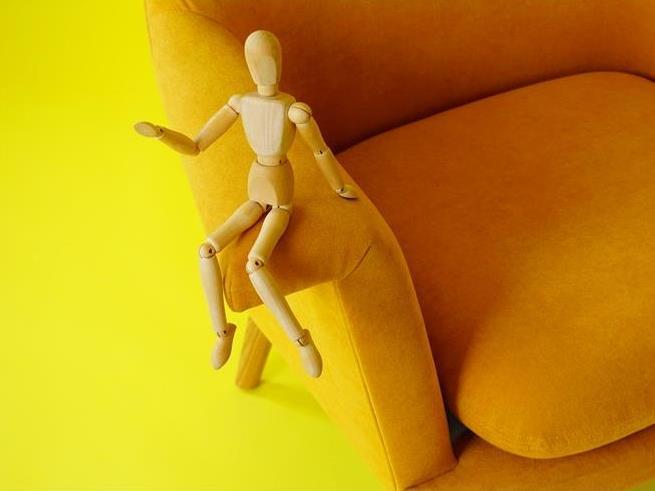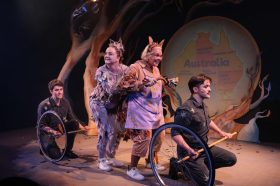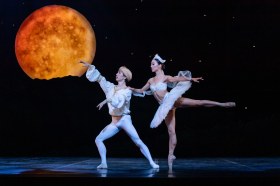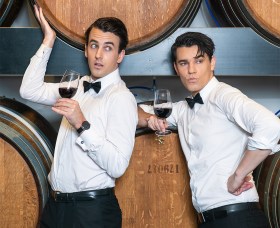Image: Unsplash
Maya Angelou once admitted, ‘I have written 11 books, but each time, I think “Uh-oh. They’re going to find out now. I’ve run a game on everybody and they’re going to find me out”.’
Perhaps what is so convincing about imposter syndrome or self-doubt is that it can feel very personal to the individual experiencing it.
It’s difficult to imagine that a renowned novelist, poet, and memoirist such as Angelou also experienced the very same uncertainty in her work as you do – where we feel convinced that we don’t know what we are doing, we simultaneously assume others possess the secrets to success.
Social media amplifies this feeling of upward comparison – our colleagues’ finished projects, rave reviews, successful grant or residency applications, new show openings, and promotions appear effortless. But behind the highlight reel, nobody knows what they are doing. Everyone has sleepless nights, dull days, creative lulls, abandons projects, experiences rejection, and battles with self-doubt.
Read: How to handle criticism and naysayers
When we keep in mind that no one knows what they are doing, instead of feeling like it’s impossible to catch up, an opportunity to learn how others move through uncertainty in their careers opens up.
Here, visual artists, writers, and new media artists share how they have learned to trust themselves, their work, and their audiences to gain experience and momentum for their work.
Start with the work and let it carry you through
When photographer Brandon Stanton, the creator of the immensely popular project Humans of New York was just starting out, there were days he would experience rejection after rejection after rejection.
‘When you walk up to somebody and you ask them if you can take their photo and they respond like you’re some sort of freak or that you’re weird, it’s hard to not internalise that because you’re so insecure at the moment about whether or not what you’re doing is weird … there’d be days where that would happen, and I just couldn’t do it anymore. And I would just go home and lay in bed,’ he told Tim Ferriss in a podcast interview.
Read: 45 ways to spot, overcome and enjoy a creative lull
When there is so much doubt, very little money, and nobody is paying attention to the work, it can be difficult to find the inner reserves to keep going with a project. But for Stanton, what kept him going was just doing the work.
‘Whenever I started to think, “Is this gonna work? Is it not gonna work?” I’d just go out and photograph. That was my only way of keeping those wolves away of, “Is this ultimately going to be a success? Am I wasting my time? Am I stupid?”
Not knowing what you’re doing as a sign you’re doing it right
Santilla Chingaipe is an award-winning journalist and documentary filmmaker. After spending nearly a decade working for SBS, last year she made the switch to pursue a freelance career and develop her own projects.
Attributing a lot of her career success to surprise opportunities and connections, Chingaipe doesn’t try to quell self-doubt, but rather uses it as a measure of whether she is on the right track.
‘I like to challenge myself and if it feels “easy” then I don’t see the point of doing it,’ she explains. ‘So every time I start working on a new project, I always feel like I don’t know what I’m doing. It’s also my gauge of whether I’ve challenged myself enough.’
This is part of the freedom of freelancing – the opportunity to decide what you want to do and how you want to do it, she explains.
‘I think the more you create work, the more you are able to identify what your voice is and once you do, being able to create the space to focus and strengthen that voice is vital because it’s easy to be distracted by other work opportunities.’
Such feelings of self-doubt don’t simply dissipate once we decide to put a positive flip on them, but instead give us the space to reach out and look for what we need to make the next step – even while we feel the doubt.
For Chingaipe, these means reaching out to potential mentors – formal and informal. ‘I power through the self-doubt that creeps in by talking to peers that are older and have experienced those feelings,’ she adds.
Trust that your dream career evolves over time
Artist, curator, writer and arts worker Nikki Lam describes her career to date as ‘a bit of controlled chaos’ as she maintains both an independent art practice and a career in the arts industry as a producer.
‘I’m always second-guessing my decisions around certain opportunities, and you realise that it’s almost impossible to “get it right”. It all depends on where you’re looking at it from, which perspective you choose to see it from. I think wearing both hats – arts worker and artist – gives you relative clarity on how certain opportunities happen in certain ways. But that same clarity can also be disheartening at times. So it’s really a double-edged sword,’ she explains.
Lam recently made the decision to leave her ‘dream job’ in order to have more time for her own artistic projects, an experience she describes as both an evolution and a privilege.
‘I think that “dream job” evolves over time. A year ago I might have been passionate about something that was different to what I’m passionate now. I think that the safe option is always listening to what you need in order to thrive. But I also realise my own privilege to be able to “quit a dream job” – It would not have been possible a few years ago. Not being a permanent resident and all.”
To navigate your career and better trust your decisions, it’s important to build a community around you, adds Lam.
‘Not in a “networking” way, but peers who understand your work, who support your practice, who would show up to your opening and tell you when they don’t enjoy your work,’ she said.
Experiment with your level of risk and security
For Jeremy Bailey, a ‘famous new media artist’ and founder of Lean Artist, the world’s first seed accelerator for artists, his career to date has been half planned, half unplanned.
‘Generally I count on having several failures for every success and I’ve learned to start small and then build on the successes. Each success is a stream of work. This is relatively reliable because I can throw away a lot of ideas before I invest too much time,’ he says.
Embracing failure as a road to success requires a level of risk-taking, which Bailey once again keeps in check through a ratio split.
For Bailey, that means a day job to balance his artistic practice. ‘I’ve personally learned to make sure I have a sure fire stream of money from somewhere reliable and then build space around that to experiment without worry of financial consequence. Stress is the enemy of creativity.’
In this way, you don’t have to resist the ‘safe’ option in order to pursue your own path of creative interest, rather you can do both.
‘Safe can fund unsafe. Most large companies have a 70/30 model – 70% sustaining business and 30% innovation. Your goal should be for the 30% to replace your sustaining business operations (such as a day job) over a longer period of time, like a decade,’ adds Bailey.
Experimenting with this balance can help when you’re feeling stuck or in doubt about making the ‘right’ decision, because you can always adapt.
‘Believing in yourself is only as good as your ability to believe that you will observe and adjust to your environment. We are all capable of incredible change but first we must be capable of sensing the needs of ourselves and others in our environment. Sense and respond,’ says Bailey.
Abstract painter Alizon Gray has also found experimenting to be a great way to figure out what you want while learning along the way.
‘Sometimes it takes a while to work out what it is that you love and it is ok if it takes a long time to get there, or it changes over time. You can’t get there unless you experiment and push yourself and try new things, and you can’t be defeated if you try something new and it doesn’t work. If you have your life arranged so that you have the space and time to make work and experiment you will work out what it is you really want to be doing and be confident to put it out there – the recognition will follow,’ says Gray.
Trust the process – and yourself
Abstract art is a fitting metaphor for how many of us feel as we navigate our careers, and the various stages we encounter along the way, explains Gray.
‘Being an abstract artist I never have an outcome planned. My process is basically mucking about with paint until something happens that I like … It’s a lot of fun to paint this way, but sometimes I get in a mess and my work looks really ugly. When my paintings are in their ugly stages I often think, “Why can’t I make this work? I really have no idea what I am doing!” The great thing about paint though is that you can just keep painting over it and I have learnt to make the mistakes and the lumpy remnants of past marks part of the work.’
Our own mistakes and supposed wrong turns inform us in ways we often can’t detect, so it’s important to learn how to trust the process in the interim.
There are of course practicalities in the art of trusting yourself. For Gray, a routine that allows her to be in her studio multiple times each day while still having a level of security works well.
‘I work four days a week in my day job, which is a nice balance. My day job is also only a 30 minute bike ride from my home and studio which is important to me. When I ride home I have the space to myself to clear my mind and shift my focus to making art. Usually when I am riding, I don’t think about work, I think about the project I am currently working on in the studio, what other materials I could use, other ways of making marks, or how I will define the next project to bring in a new challenge,’ she explains.
Routine has also formed part of her art practice, with a series developed from creating a painting every day for 180 days.
We often don’t know where our work will lead us, but the daily painting projects are examples of how it’s about doing the work, and showing up every day that counts.
‘Whether I felt like painting or not, I found that once I had a paint brush in my hand I wanted to do more and I would stay and work longer than I had intended to. I found that committing and being in the studio even if I don’t feel like it allows for things to happen on the canvas that may not have if I was feeling enthusiastic – it all feeds in,’ she adds.
* * *
It’s comforting to learn that nobody knows what they are doing – but equally, there are tools to deal with the uncertainty. Whether it’s developing a routine, a safety net, experimenting or finding support in other people, you can develop your own career path. Perhaps most importantly, along the way you are able to find your own measure of success.
‘Letting go of the idea of success can be quite liberating. When you’re not looking to measure your work through accolades, clicks, or money, it frees you up to just make the work which involves having to trust your intuition about how to go about creating that work or telling that story,’ concludes Chingaipe.





